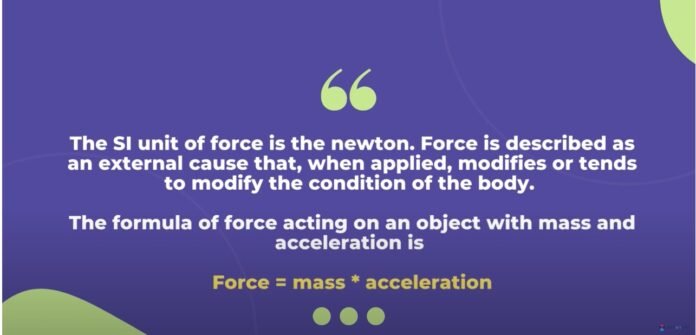Introduction
Force is a word that is widely used, observed, or seen being applied in our daily lives. Force is something that can only be felt, not seen. Force is the relationship between two substances through push and pull. To apply force, one has to answer two questions: who applies the force, and on what object is the force applied? The effects of force on a body are as follows: a force can move a stationary object, halt a moving object, and alter the pace of a moving object. e.g., the player kicking the ball, the goalie collecting the ball, and a player controlling the ball. A force can alter the size and shape of the body. e.g., stretching or pressing the spring. A force can alter the direction of a moving object. For example, consider the batter striking the ball.
Definition of Force
Force is the push and pull of an object due to interaction with each other. In other words, it is something that makes changes happen. It is expressed in the formula as
F = ma
Where F is force, m is the mass of the object and a is acceleration.
Resultant Force: It is that single force that, when acting upon a body, produces the same effect as all the other forces. It means it is the sum of all forces acting upon a body. It is also called “net force.” The resultant force is of two types: balanced force and unbalanced force.
If the resultant force of all the forces acting on an object is zero then that is called balanced force. E.g.:- A glass of water kept on the table.
If the resultant force of all the forces acting on an object is not zero then that is called unbalanced force. E.g.: For the object is pulled by a rope from the opposite direction.
Example – How much force is required to accelerate a 500 Kg trolley at 2.00m/s2?
Solution – According to the problem
Acceleration a is 2.00m/s2 and Mass is 500 kg. Putting value in the formula, we get
F = 500*2
F = 1000N
So a 1000N force is required to accelerate the trolley.
Unit of Force
The S.I. unit of force is Newton. It is denoted by N (Kg.m/s2).
Newton’s Third Law of Motion
The law states that if body A exerts a force F1 on another body B, then B exerts an equal and opposite force F2 on A, the forces acting along the line joining the bodies. The two forces F1 and F2 connected by Newton’s third law are called an “action-reaction pair”. As a result, every action has an equal and opposite reaction. This illustrates that all forces act in pairs. The two major points to be noted related to the law are that:
- The two forces are opposite in direction but equal in magnitude.
- The two forces act on different objects.
E.g., when a gun fires, the bullet goes forward, but the gun recoils backward.
Types of Force
Force is primarily divided into categories- Contact Force and Non-Contact Force. There are further sub-divides of many types.
Contact Force: As the name suggests, it is a force due to physical contact between the two bodies. The following are the types of contact forces –
- Spring force: In Hooke’s law, the spring force is explored. The displacement or movement of molecules causes the spring force. The movement of molecules is the polar opposite of the movement of springs.
- Applied force: Applied force is another term for muscle force. the force generated by muscle contractions
- Air resistance force: It’s an instance of a normal force. The force that shifts in the opposite direction when gas is present is the air resistance force. The area under contact determines how much air resistance there is; as the area grows, so does the air resistance force and the gas’s velocity.
- Frictional force: A dissipative force called friction resists an object’s motion by acting in the opposite direction to that of motion. It takes place when an object interacts with the surface or comes into contact with it and attempts to overcome the force of resistance.
- Tension force: The force that is created with the aid of a rope, cable, or string is known as a tension force. Only the attached suspended mass is pulled by this force. It is incapable of pushing.
Non-contact forces: Non-contact forces are ones where the two bodies are not in contact. This force instead acts through the space between the two bodies rather than as an outcome of direct contact between the surfaces. The following are some examples of non-contact forces:
- Gravitational force: The force exerts on massive bodies due to their mass and this force is always attractive in nature.
- Electromagnetic force: This force is caused by electric charges which produce electric and magnetic effects.
- Nuclear force: A force that operates between an atom’s protons and neutrons.
- Weak nuclear force: The force is generated during the radioactive decay of the molecules and exists between them.
Recommended Articles:
Unit of Heat
Unit of Inductance: Definition and Types
Light with Multiple Measuring Units
Magnetic Flux and Its Measuring Units
Unit of Moment of Inertia
Force is the push and pull of an object due to interaction with each other. Newton and is denoted by N (Kgm/s2). According to Newton's third law for every action there is an equal and opposite reaction. There are two types of forces—contact force and non-contact force. Unit of Force FAQs
Define force.
What is the SI unit of force?
What is Newton’s third law of motion?
What are the types of force?
